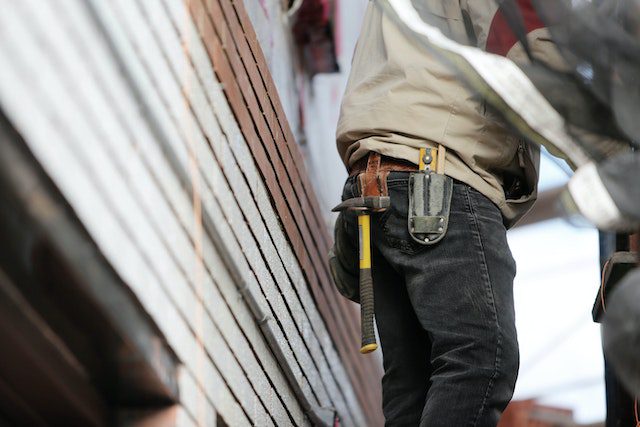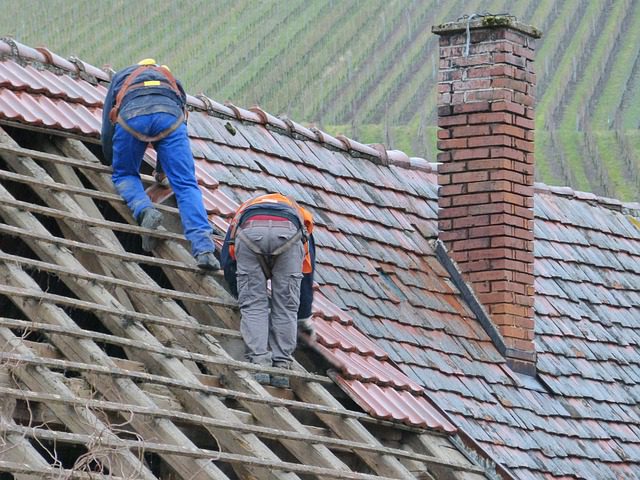
Roofers typically use tools such as roof rippers, hammers, saws, and pulleys in their daily work. They may also use analytical, computer-aided design (CAD), or project management software.
What is the job outlook for roofers? In this article, we will look at what it takes to be a roofer and what roofing involves.
Roofers spend most of their time working outside in dry weather; nevertheless, they may have to work in wet conditions, especially while performing repairs. Roofers typically put in 40 hours a week; however, the industry's seasonal nature means that this could mean less in the winter and more in the summer.
Working on a roof is a physically demanding occupation. Heavy lifting, stooping, and kneeling are all required. There is a danger of workers being burned by hot bitumen or falling from heights while working on roofs, ladders, or scaffolding.
Most incidents are avoidable if people only take the necessary safety measures. Roofing workers should exercise utmost caution when traversing a wet roof. Even more concerning is the fact that rooftops can get dangerously hot in the summer, leading to heat-related ailments.
Roofing professionals are sometimes expected to provide their own equipment by their respective employers. Many Roofers are members of the United Union of Roofers, Waterproofers, and Allied Workers.
Being a roofer is an interesting career for individuals who prefer working in the open air, don't have a fear of heights, and thrive on solving issues in a hands-on, concrete manner. Realists might find fulfillment in this line of work.
Careers that are more grounded in realism tend to deal with tangible objects like wood, tools, and machinery and emphasize hands-on experience over extensive paperwork and tight collaboration with coworkers.
Wages
Wisconsin Roofing professionals may expect a median yearly salary of $62,963 ($30.27/hr.) in 2022. The median salary is the sweet spot where half of the employees make more and half make less.
Benefits
Most union contracts for the roofing industry provide health, dental, and vision insurance, as well as paid time off, holidays, and retirement savings plans for the workers. Roofers who work alone must provide for their own health insurance and retirement savings.

Demand for Roofers is often not as influenced by the economy as other construction crafts because having a rain-tight roof is not something homeowners or business owners can put off indefinitely. With the potential for new jobs to arise from green building retrofitting, the burgeoning green economy is another positive side effect.
Projections of Employment
Across all of Wisconsin's professions, Roofers are anticipated to see a rate of growth that is about average. Between 2018 and 2028, the number of employment for Roofers is projected to rise by 8.8 percent, or by around 2,100 people.
Roofing is one of the fastest-growing industries in Wisconsin. Between 2018 and 2028, the number of employment for Roofers is projected to grow by 18.8 percent or 60 positions.
When looking for a Roofer, most businesses like to see that the candidate has either a postsecondary degree or relevant job experience. Helping more seasoned employees with activities like roof tear-offs, cleaning and prepping roof decks, carrying and stacking products, and moving ladders is a big part of a roofer's on-the-job training.
As they regularly work at great heights, roofers require training that emphasizes safety (sometimes many stories). Roofing requires a high level of physical fitness and superb hand-eye coordination and balance.
Experience
Skills in critical thinking and problem solving, as well as proficiency with hand and power tools, are highly valued by employers.
Early Profession Training

High school graduates should have solid woodworking, metalworking, elementary mathematics, and English foundations. Opportunities for training may be available through Regional Occupational Programs (ROP).
Apprenticeship Programs
Roofing companies and local unions occasionally offer apprenticeship programs so that new roofers may learn the trade from seasoned veterans. The typical duration of the program is 42 months, and that time is split evenly between classroom instruction and on-the-job training.
Apprentices are generally assumed to be of legal age (18) and in generally excellent health. Having completed the educational equivalent of a high school diploma is often necessary to enroll in any given course of study.
Continuing Education
Journey-level Roofers may be able to participate in continuing education and learn about new trends and best practices through their local unions or roofing clubs, but this type of education is not required by law.
Licensing and Certification

It is the responsibility of the contractor or employer to ensure that their workers are properly licensed before they begin work. Independent roofers in Wisconsin are required by law to register with the Contractors State License Board. If you need further info, it's best to contact the relevant licensing authority. Select the license's name to see its terms and conditions.
Certified Roof Examiner, Registered Roof Observer, and Registered Weatherproofing Consultant are just a few of the credentials that a roofer could have. Go to the "Career Tools" section of the Career InfoNet website on the U.S. Department of Labor's website for further details. To identify appropriate certification courses, select "Certification Finder" and proceed as directed.
For academic resources, you can do one of two things:
Look up programs and institutions that offer them by subject area using the "Field of Study" search option. Search terms you might use include roofer and roofing. You may use the Training Provider search to look for specific institutions by name, by kind, or by region.
Get in touch with your top choices to ask about their course offerings, cost, and required coursework.
Green Economy
Roof contractors will play a part in the new green economy by installing and maintaining green roofing. Some non-residential roofs in Wisconsin are mandated to have "cool roofs," which are covered with a specific coating that reflects sunlight rather than absorbing it, keeping the structure cooler and cutting down on air conditioning expenditures.
Skills That Are Necessary and What They Are
Green economy activities and technology are conceivable that Roofers will be affected. Work and employee needs, such as performing certain duties, learning new information, and obtaining specific qualifications, may evolve as technology develops. Below, I've included several common tasks, each with a corresponding example of the skillsets needed to complete them successfully.

Common tasks for roofers include:
A building's interior, electronics, and furnishings are protected from the destructive effects of water seepage by a properly built roof. Low-slope roofs, on the one hand, and steep-slope roofs, on the other, are the two most common styles.
Low-slope roofs are constructed in stages and have a slope of fewer than 3 inches per horizontal foot. Low-slope roofs are the most prevalent type and may be seen on the vast majority of commercial, industrial, and apartment buildings.
The installation of a low-slope roof varies in difficulty depending on the structure's intended use. Roofers often use a single-ply membrane made of waterproof rubber or thermoplastic composition for constructing low-slope roofs.
Asphalt shingles, which are relatively inexpensive, are frequently used to cover steep-slope roofs, which have a rise of more than 3 inches per horizontal foot. Asphalt shingles are commonly used for roofing detached dwellings.
In addition to the more popular asphalt shingles, roofers can also install tile, solar shingles, metal shingles, or shakes (rough wooden shingles) on steep-slope roofs.
Plants and other landscaping elements can be included in some roofing designs. For instance, a vegetative roof is a low-slope roof that is protected by a root barrier and used to grow plants and other landscape features.
Using solar panels on rooftops to generate electricity is gaining popularity. Solar reflecting systems deflect the sun's rays to avoid heat gain, while solar thermal systems use the sun's heat to warm water and solar photovoltaic systems turn sunlight into electricity, all of which can be installed on roofs.
Solar photovoltaic (P.V.) installers normally put in P.V. panels, while roofers may put in solar shingles or tiles. Technicians in the plumbing, HVAC, and refrigeration industries can also install solar thermal systems.
Depending on the roofing material, roofers may utilize a wide range of tools. To remove old roofs, they can use roofing shovels and pry bars.
New roofs can be installed with the help of a variety of tools, including hammers, nail guns, drills, knives, pavers, tape measures, chalk lines, and framing squares.
Due to the inherent danger of the position, it is essential that you be in good physical condition. The ability to work in extreme heat or cold, wind, snow, or rain, whether standing, climbing or walking carefully, is a must. Roofers ensure the safety of the building's occupants and its valuables by regularly inspecting and repairing the roof.
Roofers in the U.S. may earn an average yearly salary of $34,250, made up of a $23.87 hourly income plus $6.375 in additional compensation for working overtime. As of 25 August 2022, a salary of $3,100+ was recorded.